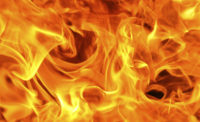 Dozens of fires sparked by high temperatures, severe drought conditions and strong winds have blanketed the western part of the U.S. including Washington, Montana, Oregon, Idaho, Nevada and California in recent months, making this fire season one of the worst in history. According to the National Interagency Fire Center (NIFC), nearly 43,000 fires burning 6.4 million acres have been reported across the West since January, and officials predict more wildfires will erupt due to continued dry heat and increased thunderstorms across the region.
Dozens of fires sparked by high temperatures, severe drought conditions and strong winds have blanketed the western part of the U.S. including Washington, Montana, Oregon, Idaho, Nevada and California in recent months, making this fire season one of the worst in history. According to the National Interagency Fire Center (NIFC), nearly 43,000 fires burning 6.4 million acres have been reported across the West since January, and officials predict more wildfires will erupt due to continued dry heat and increased thunderstorms across the region.
The Firewise Communities Program provides resources to help residents take on wildfire safety activities. Complimentary brochures, booklets, pamphlets, videos and much more can be found on the “information and resources” page of the website and ordered online through the Firewise catalog.
“This continued high heat and extreme drought, coupled with intense lightning storms, pose a greater threat to individual properties and neighborhoods across the West,” said Michele Steinberg, manager of National Fire Protection Association’s (NFPA) Firewise Communities Program. “It’s simply easier, in these conditions, for fires to start and burn out of control. But residents can do their part and take simple steps today to lessen the risk of damage if a wildfire occurs.”
Wildfire doesn’t have to burn everything in its path. In fact, cleaning your property of dead leaves, needles and branches, and maintaining your landscaping are important first steps. Below are additional actions you can take to reduce the risk of your home and property becoming fuel for a wildfire:
- Clear leaves and other debris from gutters, eaves, porches and decks. This prevents embers from igniting your home.
- Create a “fire-free” area within five feet of the home, using non-flammable landscaping materials such as rocks, pavers and/or high-moisture content annuals and perennials.
- Remove dead vegetation from under your deck and within 10 feet of the house.
- Remove flammable materials (firewood stacks, propane canisters, dry vegetation) within 30 feet of your home’s foundation and outbuildings, including garages and sheds. If it can catch fire, don’t let it touch your house, deck or porch.
- If you have trees on your property, prune so the lowest branches are 6 to 10 feet from the ground.
- Don’t let debris and lawn cuttings linger. Dispose of these items quickly to reduce fuel for fire.
- When planting, choose slow-growing, carefully placed shrubs and trees so the area can be more easily maintained.
- Landscape with native and less-flammable plants. Your state forestry agency or county extension office can provide plant information. Firewise landscaping and plants list are also available on the Firewise website.
- Keep your lawn hydrated and maintained. Dry grass and shrubs are fuel for wildfire.
Learn more about how to keep your family safe and reduce your home’s risk for wildfire damage at www.firewise.org.
